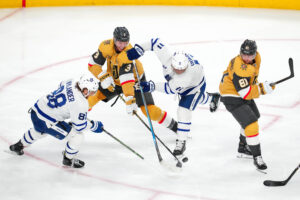The 2019-20 Vancouver Canucks home stretch is looking good for the playoffs. Now they have to hold it.
Good Weekend, Great Googly Moogly!
The St. Louis Blues were exemplary hosts for this year’s All-Star weekend, with plenty of highlights for fans in attendance.
The women’s game is the most… polite… I’ve seen the US and Canada play in years. Even so, they were full value for their 3-on-3 match. And the game-winning shot by Melanie Daoust was just nasty.
The skills competition was pretty fun, though replacing the accuracy contest’s exploding targets with a digital display was a mistake. Things going boom is fun, dang it! The in-the-stands shooting was a reasonable first effort, but it would be better if players needed to get pucks in different targets to get some variety in there. And for cryin’ out loud, they’ve GOT to cut down the number of goalies in their portion of the game. Breakaway, save series, whatever they call it: four goalies is fine.
For the All-Star Game itself, though? That the most memorable ASG in recent years was the John Scott fiasco/epic in 2016 speaks volumes. No shade on Pettersson and his two goals, though: his shots spoke for themselves. Markstrom’s spontaneous “Swedish word” was a highlight there, too. Tell me the goalies don’t care about this game again…? But the weekend is always better than the game, and if the league wants to change that, something about the game itself is going to have to change.
Gary Bettman hinted again that an “international flavour” would be in the next ASG, but we’ve been there before. How much is that going to really help? Matt Larkin from the Hockey News came up with the most interesting suggestion I’ve heard to improve the game.
It remains 3-on-3, but each trio is a current NHLer, a woman’s team member, and a retired veteran. I like that idea a lot.
Canucks Represent
As for the 2019-20 Vancouver Canucks highlights, the reaction to Elias Pettersson being in the hardest shot competition was gold. He’s never looked as skinny as when he’s beside a slew of defenders, and the jaw drops when he topped 102 MPH…
Quinn Hughes acquitted himself well, though mostly for just how comfortable he was surrounded by NHL stars. He knows he belongs there. Now the challenge is to see if he can keep his Calder-challenging pace through the rest of the season. That last 30-ish game stretch is an endurance challenge many rookies fail.
Jacob Markstrom‘s Godfrey Gao suit was not only flash but a nice touch in memory of the Vancouver fashion designer. Gao passed away in November on a film set in China at the age of 35.
Game On!
The 2019-20 Vancouver Canucks’ home stretch starts with a bang against the St. Louis Blues. The three Canuck all-stars were followed to Vancouver by the Blues, and the two teams played on Monday night to re-start their seasons. That was the rubber match, with the previous two going into extra time and the visitors winning each. The teams are on equal footing as far as their breaks go, both having the week leading into the ASG off. We’ll see whether St. Louis will be able to use the high from a very successful weekend to beat a tough home team in Vancouver. This time around the home team was able to get on the board with the Canucks surging past the Blues.
So far, the Canucks have established themselves as a playoff contender by beating the teams they are supposed to. Fortunately, that includes most of their division. The Blues are the class of the West right now, so it’s going to be a challenge for them. They went into the break on a roll, but whether any of that momentum remains for their return is debatable.
The extra rest is going to help their injured players, especially Micheal Ferland. The team insists he isn’t concussed again, but are saying nothing else beyond it being an upper-body injury.
Tetris, Hockey Edition
Should everyone return to health, the challenge becomes not only finding ice time for them but cap space as well. Their reliance on the long-term injured reserve has kept them out of dire straits, but next year looms large. Bonuses have been hit, which will carry over, and there is a lot of money not playing for them. Add unrestricted free agents Markstrom, Chris Tanev, possibly a deserving Josh Leivo, restricted free agents, and that “dead money” and they’ll be losing players they don’t want to in the Summer.
In an ideal world, the Canucks’ home stretch would have all hands available. But moves have to be made, and this year rather than next.
The challenge is going to be balancing out the players you want for this year’s push and the ones affording them. Two notable options for trades exist, one with a team looking to make a run, and the other challenging.
Option 1
Alex Galchenyuk is, by all accounts, a failed acquisition for the Pittsburgh Penguins. Traded for Phil Kessel, he has disappointed the entire season, rarely coming off the fourth line. Fortunately, the Canucks aren’t looking for a fourth-line player – and Pittsburgh apparently is, according to Pierre LeBrun. Vancouver could do better than that, with Brandon Sutter and Tim Schaller. Schaller started well this season but has been superseded by the return of Tyler Motte. The former Boston Bruins player isn’t going to be surprised by anything he sees in his new location. Likewise, Sutter in a good fit for a middle-six spot, but hasn’t been able to stay healthy in his Canucks tenure.
Galchenyuk, though a young, skilled forward, just hasn’t fit in the Penguins system and is a UFA in July. The Canucks can give him a shot on a scoring line at very little risk for the remainder of the season. If he doesn’t work out, they can move him down the lineup and wave goodbye at the end of the year. The Canucks gain cap space next year, the Penguins improve depth this one.
Cap hits work, contract numbers work, Pittsburgh doesn’t lose a third draft pick from 2020.
Option 2
Everything said of Galchenyuk can be repeated for Mikael Granlund. The Nashville Predators expected Granlund to be some added scoring punch since picking him up from the Minnesota Wild for Kevin Fiala, but he hasn’t lived up to those hopes. It is a riskier play for Vancouver, as it is any time you trade with a direct competitor. Should Nashville surge back into the chase – as they’re expected to – a deal with them could bite.
But if you’re going to make a deal, limiting your trade partners is never the best option. There are beggars, there are choosers, and then there are the teams in a cap crunch. Avoiding a possible cure for the future because of concern for the next three months isn’t going to help.
Trade too much, though, and the 2019-20 Vancouver Canucks’ home stretch could leave them too thin to compete.
Main Photo:
Embed from Getty Images






